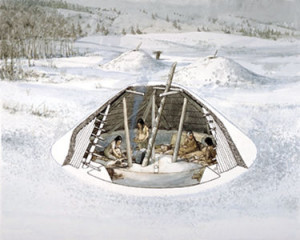Before the coming of the white man, the fertile bottom land of Winfield was dense forest, with occasional oases of small natural meadows, while the present orchard benchlands were covered with pine trees, etc. Large herds of deer roamed the ranges and bunch grass was plentiful everywhere, and grew so tall and lush that anyone passing through left a trail of bent grass.
The lakes and creeks were abundantly stocked with fish, and there was a prolific supply of all kinds of wild fruits, herbs and roots, so that conditions were ideal for the earliest inhabitants — the Indians of the Salish tribe.
They were a nomadic race, following the seasonal berry and harvest, fish and game. As dwellings they used a lean-to made from saplings, chiefly evergreens or a moundlike dwelling covered with pile matting. Contrary to general belief, the teepee was not used by the Okanagan Indians. Their winter habitations were of a more permanent nature, situated on or near the banks of a creek or adjacent to a lake.

In making these winter homes1 the Indians excavated a circle from three to five feet deep, over which a framework of pole was erected. This formed the roof and was covered with coarse pile matting with earth laid on top of this. The sole entrance was from the centre of the roof, which served also as a smoke exit or chimney. A single pole, notched in the manner of steps, served as a ladder.
Less than 200 years ago the Salish Indians were in the same primitive state as were our for[e]bears, 2000 years ago in Western Europe!2
1 Kekuli: Pit house. Sketch courtesy of the Canadian Encyclopedia.
2 Powley, Mrs. W. R. “Indian Life” in Winfield, 1958. Early days of Winfield. Mrs. W. R. Powley, comp. Winfield, BC: Winfield Women’s Institute for British Columbia Centenary, 1958. pp. 5-8.
This article about Indian life from Powley’s book contains excerpts from articles by Mr. Reginald Atkinson and Mr. W. Brent.







Sharon Weber
I may have 11 pages of Mrs. Powley’s original type-written manuscript for her book “Early Winfield” which includes the article above. I believe my mother Sally Hanet (nee Clarke), who was Samuel and Doris Tyndall’s niece, may have inherited them from her Uncle Sam. Unfortunately she passed away in 2010 so I am unable to confirm this. Would you be interested in obtaining these pages for your collection? I can send jpgs if you like.
Duane Thomson
Hi Sharon,
The Lake Country Museum and Archives is very interested in this document. We have a copy of her book but this documentation sounds wonderful. Mrs. Powley is well known because her husband, W. R. Powley, was a well known pioneer, but Gladys was raised in Oyama and spent her entire life in Lake Country. She worked with the centennial committee on this book and it is an important work by a knowledgable lady. One example is her statement that the Syilx name for Wood Lake was Pelmewash, a fact that she undoubtedly learned from some of her Syilx neighbours, but it is corroborated from other sources.
Thank you for thinking of the Museum. We would like to obtain these pages. Please call the Museum to arrange for transfer of ownership.